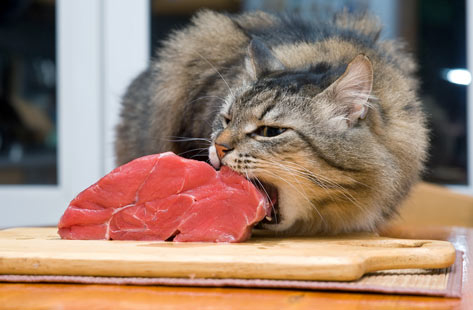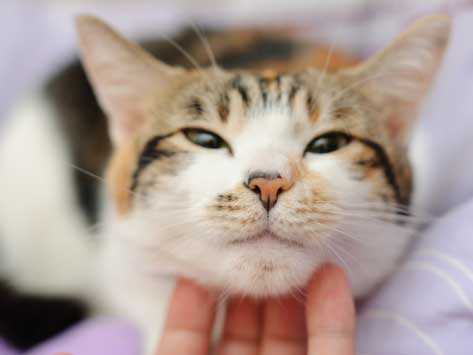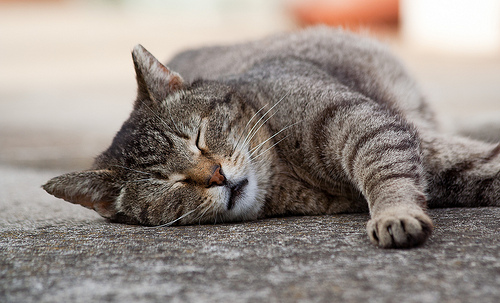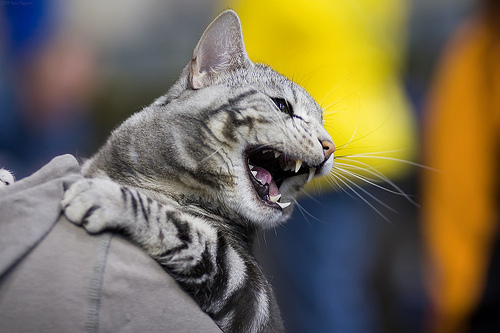The Ocicat came about totally by accident back in 1964, when Virginia Daly of Berkeley, MI, bred a Ruddy Abyssinian to a Seal Point Siamese in an attempt to get an Aby-pointed Siamese. The resulting first generations were phenotypically Abyssinian. It wasn't until one of those first generation cats was again crossed with a Siamese that the desired result of an Aby-pointed Siamese was produced, but the litter also bore another surprise, a spotted cat. Daly's daughter dubbed that cat, which was named Tonga, an Ocicat, because of its resemblance to the wild Ocelot. Subsequent breedings, with American Shorthairs added to the mix to enhance size and boning, led to placement of spots and introduced the silver color, which forms the Ocicat that you see today.
The Ocicat is distinctively different in its spotting pattern from other breeds of spotted cats. It has thumbprint-shaped spots that are inside a bulls-eye pattern. Compare that to an Egyptian Mau, for instance, which has several bands of color that fall together to form a thumbprint shaped spot.
Like other domestic breeds of cats that resemble their wilder cousins, the Ocicat looks wild and it has all of the characteristics typically found in exotic jungle cats, but their temperament is truly that of a pussycat. While dog-like in its devotion to the people who own it, the Ocicat is not a cat that is clinging or demanding, but they do love to shadow their humans closely. They don't know the meaning of the word stranger, but simply look upon them as yet another lap to curl up in for a quick catnap. Another endearing quality is that Ocicats love to ride around on your shoulders and will quite literally allow you to ferry them all over the house. Ocicats also love new playmates and are often a source of comical antics, but when they tire out, they search for the nearest person's lap for a nice long round of purring.
These are very smart animals capable of opening latches and doors, playing fetch and in at least one case, an Ocicat was known to wave 'bye-bye' to its owners. That is truly a picture that would be worth a thousand words. An Ocicat is a superb hunter, lying about in a lion-like pose, seemingly unaware until the prey comes into view. Then like lightening, they will do whatever necessary, even leaping higher than you would think they could to catch the object of their attention, then simply go back to their reclining position giving the impression that they somehow never even moved.
As with any purebred animal, responsible breeding helps to keep the Ocicat healthy and free of genetic defects. They enjoy a long life, and have been known to live for as long as eighteen years.

 Origin of Raw Food Diet for Pets
History of Raw Pet Food
By Patrick Maha
Origin of Raw Food Diet for Pets
History of Raw Pet Food
By Patrick Maha
 How Do Cats Show Love? Let Us Count Six Ways
By Cheryl Lock
They’re known for
How Do Cats Show Love? Let Us Count Six Ways
By Cheryl Lock
They’re known for
 Senior Cats: A Few Things To Keep In Mind
Taking Care of Your Furry Senior Kitizens
&nb
Senior Cats: A Few Things To Keep In Mind
Taking Care of Your Furry Senior Kitizens
&nb
 Importance of Antioxidants in Pet Food
By Jennifer Coates, DVM
Antioxi
Importance of Antioxidants in Pet Food
By Jennifer Coates, DVM
Antioxi
 Cat Scratch Fever
When people talk about cat scratch feve
Cat Scratch Fever
When people talk about cat scratch feve